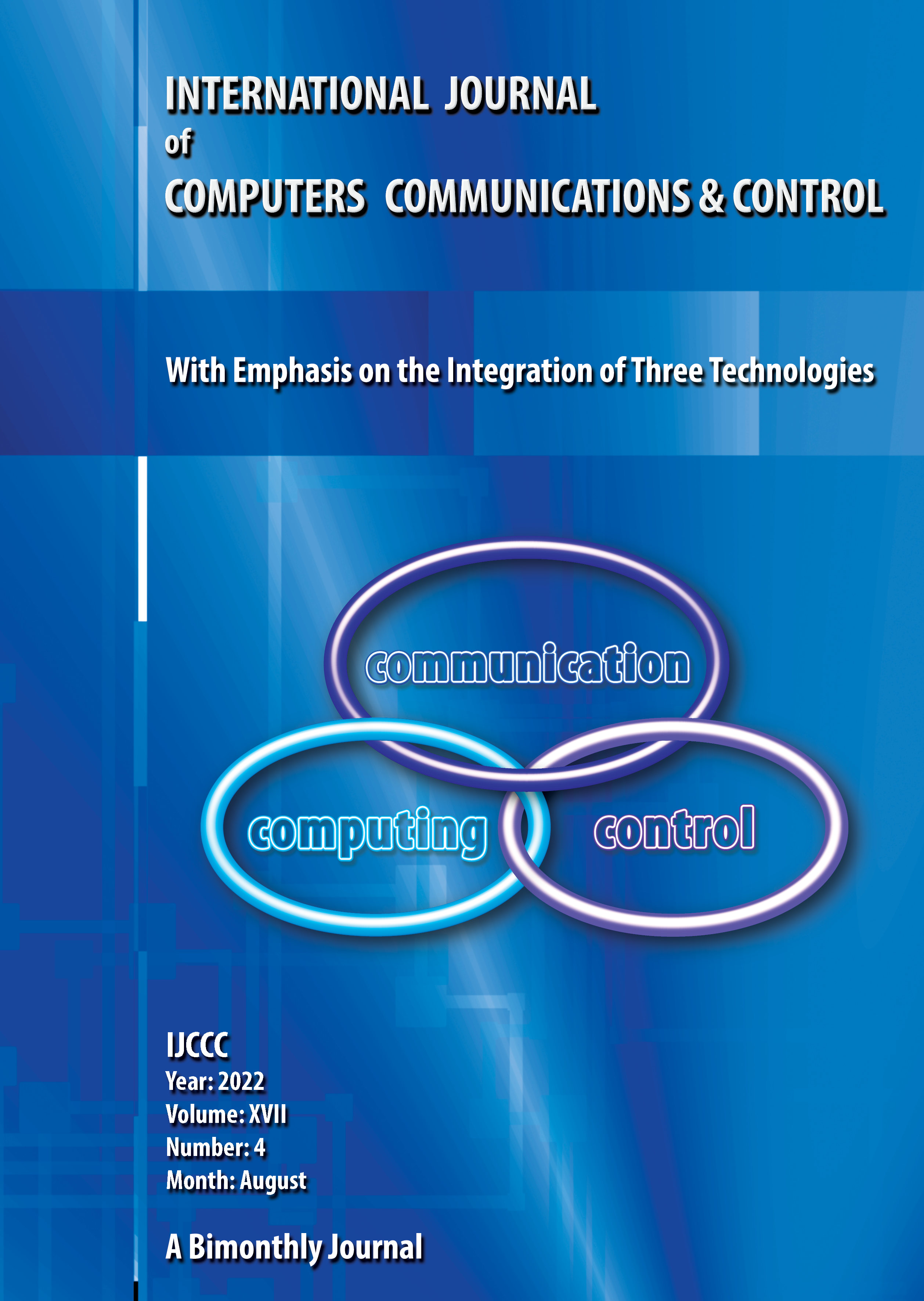A Stochastic Mobility Prediction Algorithm for finding Delay and Energy Efficient Routing Paths considering Movement Patterns in Mobile IoT Networks
DOI:
https://doi.org/10.15837/ijccc.2022.4.4861Keywords:
Markov Chains, Mobile IoT, Mobility PredictionAbstract
In Mobile IoT Networks, the network nodes are constantly moving in a field, causing interruptions in the communication paths and, thus, generating long delays at the time of building a communication path from a source IoT node to the gateway (destination node). Communication interruptions affect the delay performance in delay-sensitive applications such as health and military scenarios. In addition, these IoT nodes are equipped with batteries, whereby it is also necessary to accomplish energy consumption requirements. In summary, a gateway node should not receive messages or packets coming from the IoT nodes with undesired delays, whereby it is pertinent to propose new algorithms or techniques for minimizing the delay and energy consumption experimented in the IoT network. Due to IoT nodes are attached to humans, animals or objects, they present a specific movement pattern that can be analyzed to improve the path-building with the aim of reducing the end-to-end delay. Therefore, we propose the usage of a mobility prediction technique based on a Stochastic Model to predict nodes’ positions in order to obtain minimum cost paths in terms of energy consumption and delay in mobile IoT networks.Our stochastic model is tuned and evaluated under the Markov-Gauss mobility model, considering different levels of movement randomness in order to test how the capability prediction of our proposal can impact the delay and energy consumption in mobile IoT networks in comparison with others routing algorithms.
References
I. F. Akyildiz and M. C. Vuran, Wireless Sensor Networks, 2010.
https://doi.org/10.1002/9780470515181
J. Zheng and A. Jamalipour, Wireless Sensor Networks: A Networking Perspective, 2009.
https://doi.org/10.1002/9780470443521
A. A. Ahmed, An enhanced real-time routing protocol with load distribution for mobile wireless sensor networks. Computer Networks, vol.57, 2013.
https://doi.org/10.1016/j.comnet.2013.02.003
A. A. Ahmed, Real-Time Wireless Sensor Networks. University of Virginia, 2007.
https://doi.org/10.1109/ICDCS.Workshops.2008.70
B. Buchli, F. Sutton and J. Beutel. GPS-Equipped Wireless Sensor Network Node for High- Accuracy Positioning Applications. Wireless Sensor Networks Lecture Notes in Computer Science, Vol. 7158, pp 179-195, Springer, 2012
https://doi.org/10.1007/978-3-642-28169-3_12
S. Li, X. Ma, X. Wang, M. Tan. Energy-efficient multipath routing in wireless sensor network considering wireless interference. Journal of Control Theory and Applications. Vol. 9, Issue 1, pp. 127-132. 2011.
https://doi.org/10.1007/s11768-011-0263-4
G. M. de Araújo, J. Kaiser and L. B.Becker . Genetic Machine Learning Approach for Link Quality Prediction in Mobile Wireless Sensor Networks. Cooperative Robots and Sensor Networks. 2014.
https://doi.org/10.1007/978-3-642-39301-3_1
G. M. de Araújo, J. Kaiser and L. B.Becker. An Optimized Markov Model to Predict Link Quality in Mobile Wireless Sensor Networks. 2012.
https://doi.org/10.1109/ISCC.2012.6249313
J. A. Torkestani Young. Mobility prediction in mobile wireless networks. Journal of Network and Computer Applications. Vol.35, 2012.
https://doi.org/10.1016/j.jnca.2012.03.008
A Community Resource for Archiving Wireless Data At Dartmouth. http://crawdad.org/.
A. Habib, S. Saha, A. Razzaque, Mamun-or-Rashid, G. Fortino and M. Hassan. J. Kaiser and L. B.Becker. Starfish routing for sensor networks with mobile sink. Journal of Network and Computer Applications. 2018.
https://doi.org/10.1016/j.jnca.2018.08.016
A. Kaswan, V. Singh and P. K. Jana. A multi-objective and PSO based energy efficient path design for mobile sink in wireless sensor networks. Pervasive and Mobile Computing. 2018.
https://doi.org/10.1016/j.pmcj.2018.02.003
N.N. Srinidhi, S.M. Dilip Kumar and K.R. Venugopal. Network optimizations in the Internet of Things: A review. Engineering Science and Technology, an International Journal 2018.
https://doi.org/10.1016/j.jestch.2018.09.003
Z.Shah, A. Levula, K. Khurshid, J- Ahmed, I. Ullah, and S. Singh. Routing Protocols for Mobile Internet of Things (IoT): A Survey on Challenges and Solutions, MDPI Electronics Journal, 2021. DOI: 10.3390/electronics10192320
https://doi.org/10.3390/electronics10192320
L. Farhan, R.S. Hameed, A.S. Ahmed, A. H. Fadel, W. Gheth, L. Alzubaidi, M. A. Fadhel, and M. Al-Amidie. Energy Efficiency for Green Internet of Things (IoT) Networks: A Survey, MDPI Network Journal, 2021. DOI: 10.3390/network1030017
https://doi.org/10.3390/network1030017
H. Farag and C. Stefanovic. Congestion-Aware Routing in Dynamic IoT Networks: A Reinforcement Learning Approach, ArXiv Computing Research Repository, 2021.
https://doi.org/10.1109/GLOBECOM46510.2021.9685191
R. Aljarah and B. Mahmood. Towards the Impact of Mobility Patterns on Network Resources in Smart Cities. 6th International Engineering Conference, 2020. DOI: 10.1109/IEC49899.2020.9122883
https://doi.org/10.1109/IEC49899.2020.9122883
Chuan-Chin Pu, Chuan-Hsian Pu and Hoon-Jae Lee. Indoor Location Tracking using Received Signal Strength Indicator. Emerging Communications for Wireless Sensor Networks. 2010.
M. Rajesh, K. Vanishree and T.S.B Sudarshan. Stable route AODV routing protocol for mobile Wireless Sensor Networks. International Conference on Computing and Network Communications (CoCoNet). IEEE, 2015.
https://doi.org/10.1109/CoCoNet.2015.7411300
Germán A. Montoya, Carlos Lozano-Garzón and Yezid Donoso. Energy-Efficient and Delay Sensitive Routing Paths using Mobility Prediction in Mobile WSN: Mathematical Optimization, Markov Chains, and Deep Learning Approaches. IEEE Access Journal. 2021. DOI: 10.1109/ACCESS. 2021.3124737
Additional Files
Published
Issue
Section
License
Copyright (c) 2022 Horea OROS

This work is licensed under a Creative Commons Attribution-NonCommercial 4.0 International License.
ONLINE OPEN ACCES: Acces to full text of each article and each issue are allowed for free in respect of Attribution-NonCommercial 4.0 International (CC BY-NC 4.0.
You are free to:
-Share: copy and redistribute the material in any medium or format;
-Adapt: remix, transform, and build upon the material.
The licensor cannot revoke these freedoms as long as you follow the license terms.
DISCLAIMER: The author(s) of each article appearing in International Journal of Computers Communications & Control is/are solely responsible for the content thereof; the publication of an article shall not constitute or be deemed to constitute any representation by the Editors or Agora University Press that the data presented therein are original, correct or sufficient to support the conclusions reached or that the experiment design or methodology is adequate.








